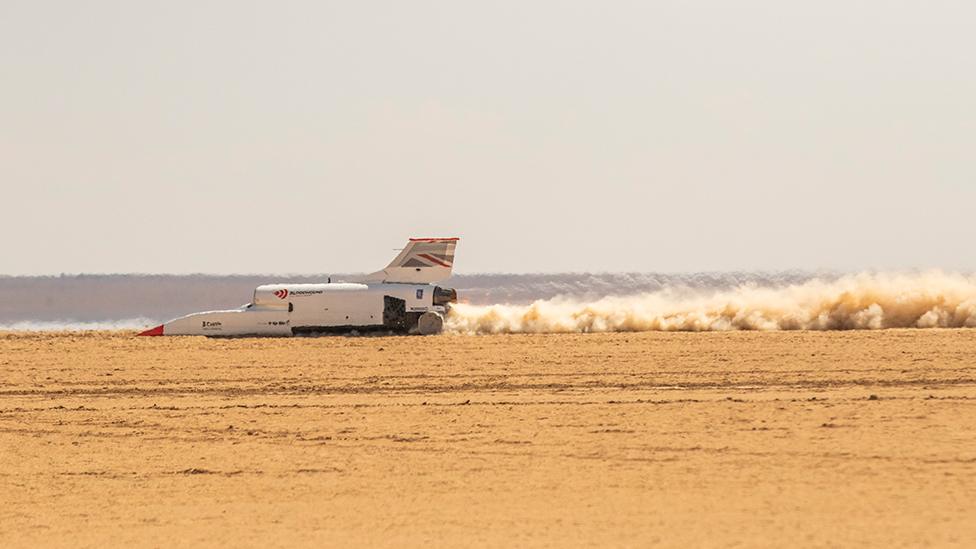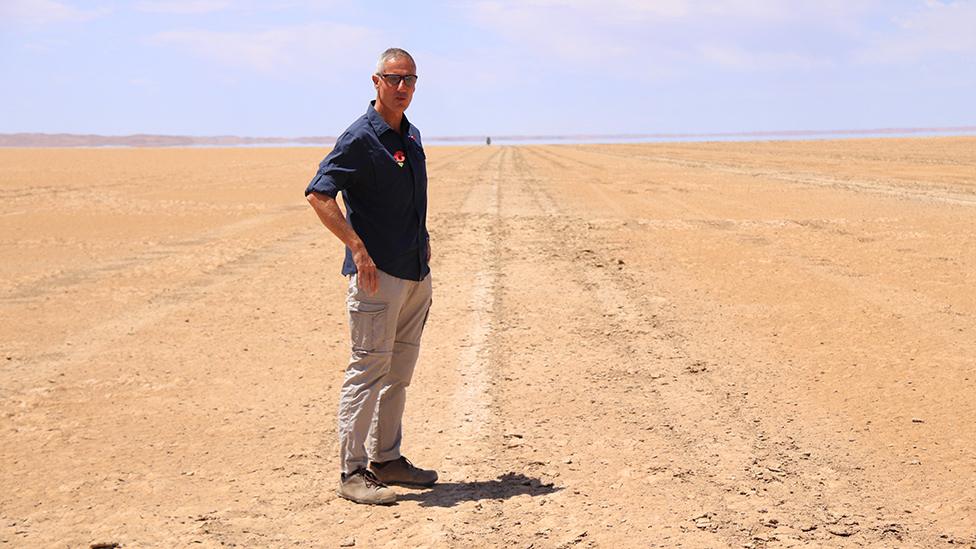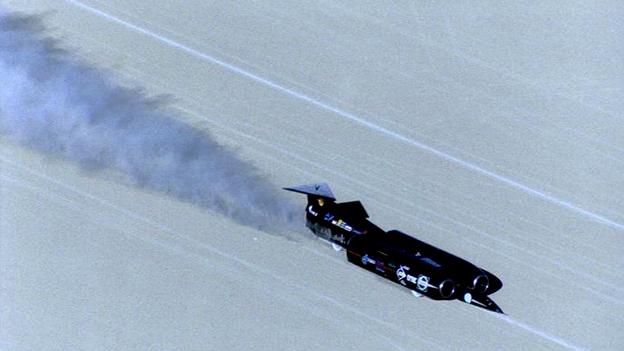Plan to revive Bloodhound UK land speed race car
- Published
Watch how the Bloodhound supercar gets off the line
The UK wants another crack at the world land speed record and needs a driver for its Bloodhound supersonic car.
To be in the running, you'll need to prove you can handle travelling at more than 800mph (1,290km/h), and have a major sponsorship deal behind you.
Bloodhound has been sitting in the Coventry Transport Museum since impressing on testing runs in South Africa's Kalahari Desert in 2019.
To go racing again and break the land speed record would likely cost £12m.
The Covid pandemic scuppered attempts to raise the necessary cash four years ago, but team leader Stuart Edmondson is convinced the time is now right to revive the mission.
And he's going to pursue an approach that's often seen in other categories of motorsport, where the driver brings with them a substantial package of funds to essentially buy the seat.
It's how some of the greats in Formula 1, like Michael Schumacher, first got their chance.
Mr Edmondson is not saying the applicant has to have come from a specific background but they will need the right aptitude.
"They've got to have certain skills and experience. I need a particular mind to sit in Bloodhound. It's all about discipline in a challenging environment," he told BBC News.
From the Bloodhound project's inception to its African test runs, the driver was Andy Green, the former RAF pilot who set the current supersonic land speed record of 763mph (1,228km/h) way back in 1997.
He's now handing on the baton to the next generation, but will continue to advise behind the scenes.

Bloodhound achieved 628mph using only its jet engine. Record runs would also use a rocket
As for the car itself, it was in good condition, said Mr Edmondson.
Sensitive components, such as its EJ200 Eurofighter jet engine, have been removed and put in safe storage. The Defence Secretary Grant Shapps has assured the team the power unit will be made available again if the project goes racing once more.
Mr Edmondson said the car would first need to be stripped down and then rebuilt, with the aim of running at speed in June/July of 2025. As before, this would take place on Hakskeen Pan, an immense mudbed in Northern Cape.
When Bloodhound raced there in 2019, it achieved a top speed of 628mph (1,010km/h). The mark put it among the top eight fastest cars or all time. But what made Bloodhound's performance really noteworthy was it completed its runs using just the EJ200. The car had been designed to also carry a monopropellant rocket.
Subsequent modelling indicated that with the two power units thrusting in tandem, the vehicle should be capable of travelling considerably faster than the existing world record.

Andy Green is handing over to a new generation of racers
Like Andy Green, Mr Edmondson had a successful career in the RAF and today continues to work with the military in a consultancy role, advising on solutions to decarbonise planes, including through the use of synthetic fuels.
The Bloodhound team leader wants the land speed racer to follow this route also.
Its monopropellant rocket would use high test peroxide which decomposes into a hot mix of steam and oxygen to provide thrust. But it needs first to be forced over a catalyst and that requires a pump driven by a separate engine. An electric solution will be sought for this, making Bloodhound a hybrid vehicle.
"People might say land speed records are no longer relevant. Yes, they can be," argued Mr Edmondson.
"We can still push engineering boundaries and go with the way the world is changing. We can operate that EJ200 without using a drop of fossil fuel and we can use an electric motor for the pump. We can set the first net-zero land speed record in 2025."
The only other cars to have run above 600mph were Sonic 1, Blue Flame, Thrust2, Budweiser Rocket, Sonic Arrow, Aussie Invader III, and Thrust SSC.
A full-scale model of Bloodhound is being taken on a short tour, external around southern England over the next few days to announce its emergence from hibernation.

Andy Green set his record in Thrust SSC on America's Black Rock Desert in 1997
